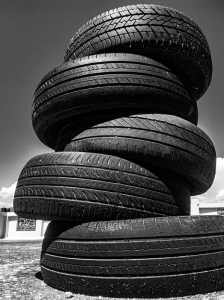Drivers Can Keep Rolling with These Tire Tips from Ford Service …
Different regions require different tires for the smoothest driving conditions.
Certified mechanics can help customers choose the best kind of tires for their driving needs.
Ford Logo Ford Service Coupon offers some tips and tricks for choosing the right tires and keeping them in good shape. CINCINNATI, OHIO, UNITED STATES, April 6, 2023/EINPresswire.com/ — Tires are an often overlooked element of a car despite the fact that they’re necessary to keep it rolling.
They’re the only part of a vehicle that comes into direct contact with the road, making them one of the most critical components of a car’s safety and performance. With a wide variety of tire types and attributes available, Ford Service Coupon asserts that it’s essential for drivers to understand how to choose the right tire for their driving needs as well as how to maintain and care for them properly. A Tire with the Right Attire
Depending on a driver’s locale, habits, and hobbies, the type of vehicle tire they need could be very different from what their neighbor buys. People who rack up the most mileage on city roads will buy a set of tires completely unlike those that an off-roading enthusiast would purchase. There are several kinds of tires on the market, so it can be difficult to narrow down which one is best for a particular situation.
Some of the most common types of tires (and the situations they’re good for) include the following: – All-season tires provide a balance of traction and handling in different weather conditions, including dry, wet, and light snow. They are suitable for drivers who don’t encounter extreme weather conditions regularly and want a tire that can perform well in different seasons.
– Summer tires are designed to provide maximum grip and handling in dry and wet conditions. They are made of softer rubber compounds and have shallower tread patterns, which make them less effective in snow and ice. – Winter tires provide maximum grip and handling in snowy, icy, and wet conditions.
They have deeper tread patterns and softer rubber compounds that remain pliable at low temperatures, providing better traction in cold weather. – Performance tires are typically used by high-performance vehicles that require maximum grip and handling. They have wider tread patterns and softer rubber compounds that provide better traction and handling in dry conditions.
However, they may not perform well in wet or snowy conditions. – All-terrain tires are developed for off-road use and provide better traction on unpaved roads, mud, and sand. They have deeper tread patterns and larger shoulder blocks that provide better grip and handling in rugged conditions.
– Run-flat tires allow drivers to continue driving even after a puncture or loss of air pressure. They have reinforced sidewalls that support the vehicle’s weight, allowing the driver to continue driving at reduced speeds and for a limited distance. Rolling on a Budget
When the time comes to purchase new tires, drivers should carefully consider several factors before selecting their next set. In addition to choosing tires that suit their driving habits and any applicable climate factors, they should also think about characteristics like noise and fuel consumption. For example, off-road tires tend to have aggressive tread patterns to help them climb over obstacles and unstable ground.
This makes them great for off-roading, but these chunky tread blocks produce much more noise than street or highway tires. Some performance tires are also capable of being noisier thanks to their softer rubber compounds and wider tread patterns. Conversely, for drivers who want quieter tires, highway or touring tires are considered good choices.
These kinds of tires are purposefully designed to provide smooth, quiet rides along with high-speed stability. Some all-season tires also boast quiet tread designs that ensure low road noise during trips. Generally, tires with low aspect ratios tend to be quieter than those with higher aspect ratios since they produce less noise at high speeds.
It’s important for customers to note that tire noise levels can also be affected by the road surface and the vehicle’s suspension system. If a car has a worn or damaged suspension system, that could potentially amplify road noise. Some tires may also produce different noise levels depending on the surface they drive on.
When in doubt, drivers can consult a professional mechanic or tire expert like the ones employed at local Ford dealerships. Fuel economy is another important factor to consider, especially for drivers on a tight budget. Larger tires are heavier and decrease fuel economy, whereas smaller tires are more lightweight and thus increase fuel efficiency.
Bigger tires also have higher rolling resistance, meaning that they require more power to start rolling. Smaller tires use a lot less power to begin moving, which makes them beneficial for drivers who are often stuck in stop-go traffic. However, larger tires require less energy to cover more ground, so once a car is in motion, they actually have better fuel economy than smaller tires.
Therefore, drivers who spend more time in city traffic may want to invest in smaller tires for their lower rolling resistance, while folks who frequently take long drives on the highway should acquire larger tires. Keeping Tires from Early Retirement Regardless of type or size, tires need regular care to stay in good shape.
The lifespan of a set of tires depends on several factors, including the type, driving conditions, maintenance, and usage patterns. In general, if kept in good condition, most tires can last for around 50,000 to 70,000 miles before needing to be replaced. However, this is just a rough estimate, and some tires may last longer or shorter depending on various factors.
For example, tires used in severe driving conditions, such as high temperatures or rough terrain, may wear out more quickly than those used in more moderate conditions. Similarly, tires that are not maintained properly, such as those with improper inflation or alignment, may wear out faster than those that are. Additionally, driving habits can also affect tire lifespan.
Frequent high-speed driving, hard braking, and aggressive cornering can cause tires to wear out more quickly than those driven more conservatively. To maximize the lifespan of a set of tires, Ford Service Coupon strongly recommends that drivers follow the manufacturer’s recommended maintenance schedule, such as regular tire rotations, wheel alignments, and maintaining proper tire inflation. Additionally, avoiding harsh driving habits and driving in severe conditions as much as possible can also help extend tire life.
Regular inspections for signs of wear or damage, such as tread depth, cracking, or bulges, can also help catch any potential issues early and avoid premature tire failure. Upkeep Under Pressure Tire pressure is one of the most crucial components of a tire’s performance.
It affects how much surface tension a tire has with the road beneath it. Too much or too little pressure can both negatively affect a tire’s condition and performance. Overinflated tires can cause drivers to lose traction and wear down the center treads of their tires faster than the edges since the contact patch with the road below is reduced.
If this occurs, the tires may last only half as long as normal. Additionally, too much pressure could cause the tire to become deformed or even explode. On the other hand, underinflated tires become less stable and have slower responses to a driver’s steering input.
Like overinflated tires, they lose grip and traction with the road beneath them. More of a tire’s rubber will touch the road, increasing friction and possibly resulting in a blowout. Their braking distance also lengthens considerably, which can be hazardous if a driver is trying to avoid an accident.
Not only do incorrect amounts of pressure pose potential threats to the condition of the tires and the safety of the car’s passengers, but this imbalance also makes for an uncomfortable ride. Overinflated tires can make a ride feel harsh and bumpy, while underinflated tires give car rides a “spongy” feeling. For best results, vehicle owners shouldn’t fill their tires to the exact maximum pressure so they can allow room for extra pressure generated by heat while driving.
Staying a few psi underneath the maximum amount listed is the best option. Since tires lose about 1 to 3 psi per month, it’s important for drivers to make a habit of regularly checking their tire pressure. Extended periods of neglect can lead to greater psi loss.
Additionally, tire pressure should only be checked when a tire is “cold,” meaning that it hasn’t been driven on enough to generate heat yet. This allows for more accurate results when using a tire pressure gauge. Going in Circles with Rotations
Tire rotations involve moving the position of the tires on a vehicle to ensure even wear and extend tire life. The front tires typically wear out more quickly than the rear ones due to steering and braking, which can cause uneven wear patterns. By rotating the tires regularly, drivers can help ensure that they wear out evenly and extend the overall lifespan of the tire set.
The recommended frequency of tire rotations varies depending on the make and model of the vehicle, as well as the driving conditions. However, as a general rule of thumb, it’s recommended to rotate the tires every 6,000 to 8,000 miles, or as specified by the vehicle manufacturer. Some signs that a vehicle may need a tire rotation include uneven wear patterns on the tires, such as more wear on one side than the other or more wear on the front tires than the rear ones.
Additionally, if a driver notices that the vehicle is pulling to one side or that the steering feels off, it may be a sign of uneven tire wear and a need for rotation. Regular tire rotations can help extend the lifespan of a set of tires and improve overall vehicle safety and performance. By ensuring even wear, drivers will avoid premature tire failure and maintain optimal traction and handling on the road.
Scheduling regular maintenance like rotations and pressure checks can lengthen the lifespan of a set of tires. Ford Service Coupon hopes that drivers will take the time to bring their vehicles to professional mechanics for service, such as those at local Ford dealerships. Good upkeep and a watchful eye will prevent a set of tires from retiring too early.
Affording maintenance service can be difficult for many, but it doesn’t have to be with Ford Service Coupon, a money saving service available to all Ford customers in the Virginia, West Virginia, Ohio, Kentucky, and Tennessee areas who need to save on essential auto services. Maintenance is a crucial part in owning any vehicle and Ford Service Coupon aims to help drivers across the country get the services they need the most at a price no one can beat. For more information on how Ford Service Coupon is helping these communities call 859-341-6603 or email them at [email protected].
Cincinnati South Ford Dealers Advertising Fund, Inc
Ford Service Coupon
+1 859-341-6603
email us here
Visit us on social media:
Facebook
Twitter
Instagram
![]()
You just read:
News Provided By April 06, 2023, 09:45 GMT Share This Article
EIN Presswire’s priority is source transparency.
We do not allow opaque clients, and our editors try to be careful about weeding out false and misleading content. As a user, if you see something we have missed, please do bring it to our attention. Your help is welcome.
EIN Presswire, Everyone’s Internet News Presswire(TM), tries to define some of the boundaries that are reasonable in today’s world.
Please see our Editorial Guidelines for more information.








